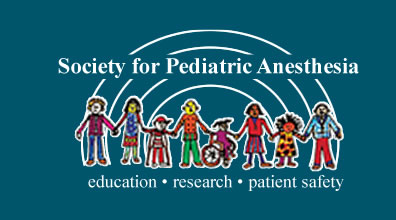Significant Pediatric Anesthesia Articles
Sunday, October 17th 2010
 By Olutoyin Olutoye, MD
By Olutoyin Olutoye, MD
Texas Children’s Hospital
An interesting session of the ASA included the presentation of 2010’s significant pediatric articles from different journals, monitored by Constance Houck, MD, FAAP (Boston Children’s).
Helen V. Lauro MD (SUNY Downstate Medical Center) presented the following articles from PEDIATRICS:
- Meltzer LJ et al.: Prevalence of sleep disorder in primary care pediatric practices.
Background - Sleep disorders are common in youth and are underdiagnosed as pediatricians do not routinely inquire about sleep patterns.
Implications: There is a need for awareness of sleep disorders among children as well as sleep disorder education on diagnosis and treatment amongst practitioners. - Nafiu et al. Neck circumference as a screening measure for identifying children with high body mass index.
Neck circumference (NC) shows high correlation with weight, height and body mass index (BMI) in boys & girls; however NC correlates better with weight and BMI in boys compared to girls.
Conclusion - NC is a low cost, quick and easier anthropometric measure to obtain compared to weight and BMI, it has good inter-rater reliability and is very well accepted by patients and providers.
Limitation of study - Only single, one-time NC measurements were obtained.
Andrew Davidson MBBS, MD, FANZCA (Royal Children’s Hospital) presented these articles from ANESTHESIOLOGY:
- Brambrink et al. Isoflurane induced neuroapoptosis in neonatal rhesus macaque brain: isoflurane or ischemia-reperfusion?
Clinical implications: This study provided more evidence that general anesthesia can be neurotoxic to the developing brain. However, the functional outcome of general anesthesia induced neurotoxicity is still unknown.
Issues remain regarding translating the results across species (animals and humans) with regards to the dose and duration of anesthesia as well as age correlation.
Inference: Do not administer general anesthesia to neonates unless absolutely necessary - Briner et al. Volatile anesthetics rapidly decrease dendritic spine density in the rat medial prefrontal cortex during synaptogenesis.
Background: In addition to apoptosis, there is a concern that volatile anesthetics also affect synaptogenesis during brain development.
The effect of different concentrations of volatile anesthetics: 1.5% isoflurane, 2.5% sevoflurane & 7% desflurane at 30, 60 & 120 minutes on dendritic spines in 16 day old rats was studied.
Clinical Implications: This study raises questions as to whether the effect of anesthesia on the developing brain may extend over longer periods of time than previously thought. - Westin BD et al.: Validation of a pre-clinical spinal safety model: effects of intrathecal morphine in the neonatal rat.
Aim: In light of concerns regarding neuroapoptosis following general anesthesia, the goal of this study was to determine the safety & dose dependent toxicity of intrathecal morphine on the spinal cord in rats. The spread & volume of intrathecal morphine, increasing doses of intrathecal morphine, and spinal cord histopathology, apoptosis and gliosis @ 1 and 7 days after postnatal 2 and postnatal 21day injection were studied. Sensory threshold and gait analysis were also analyzed.
Results: Intrathecal injections can be reliably performed at all ages in post natal rat pups with no adverse effects
Clinical implications: Neuraxial morphine is probably a good choice for analgesia in young children. - Walker SM et al. Effects of intrathecal ketamine in the neonatal rat: Evaluation of apoptosis and long-term functional outcome.
Aim of study: To determine safety of intrathecal ketamine in rats.
Results: Increased apoptosis and long term functional effects were observed at the same doses that reversed anti-hyperalgesia.
Clinical Implications: Neuraxial ketamine has a narrow therapeutic window and should be utilized with caution in pediatric caudal blocks. - Erb et al. Fentanyl does not decrease the incidence of laryngospasm in children anesthetized with sevoflurane.
Aim: To determine effect of increasing doses of fentanyl on laryngeal and respiratory reflexes in children.
Results: 2 successive doses of 1.5 mcg/kg of fentanyl did not prevent laryngospasm in children
Clinical implications: Opioids may have little effect on laryngospasm. A lot is still unknown about laryngospapsm and more research is required in this area. - Rigouzzo A et al. Pharmacokinetic-Pharmacodynamic modeling of propofol in children
Aim: To determine the best model to describe pharmacokinetic and pharmacodynamics of propofol in pre-pubertal children in order to calculate the corresponding pharmacodynamic parameters.
Methods: 16 children included in the study had induction of anesthesia using plasma target controlled infusions of propofol (6ug/ml) based on the Kataria model in children and Schnider model in adults. The relationship of bispectral index to predicted concentrations was studied during induction using the BIS using the Kataria, pediatric Marsh, Shuttler and Schnider models in children.
Results: The predicted concentration/ effect relationship was best described using the Schnider model described for adults compared to classic pediatric models. The Schnider model might be useful for target controlled infusions in children compared to the classic pediatric models.
Peter Davis MD (Children’s Hospital of Pittsburgh) provided information on the following articles from ANESTHESIA & ANALGESIA:
- Tait AR et al. Presenting research risks and benefits to parents: does format matter?
A sham study was presented to parents in different modes namely text, table and pictographs to see if there was any difference in processing of the information & how it was received.
Results:
• Processing was better in the table and pictograph format even in the less literate group.
•Parents preferred a tabular form for determining the risks and benefits and for clarity of the information. - Rusy LM et al. Gabapentin use in pediatric spinal fusion: randomized, double-blind, controlled trial.
Background: Gabapentin’s opioid sparing effects have been studied in adult surgical patients but not in children
Methods: Patients aged 9-18 years received pre-operative gabapentin (15 mg/kg) or placebo, received a standardized anesthetic and standardized patient controlled opioid and continued on gabapentin 5 mg/kg or placebo, three times a day for 5 days. Total opioid use was calculated in mg/kg/time intervals. Pain scores and opioid side effects were recorded.
Strengths of study: This was a registered trial with informed written consent obtained. 63 patients with idiopathic scoliosis received 15 mg/kg gabapentin versus placebo.
Weakness of study: 1-5 surgeons were involved.
Results: Gabapentin group had significantly less morphine requirement in the post operative care unit and on post operative 1 & 2. By post operative day 3 & 4, the morphine consumption was equal in both groups. There was no difference in morphine-related side effects between groups. - Ramamoorthy C et al. Anesthesia related cardiac arrest in children with cardiac disease: The data in the peri-operative cardiac arrest registry (POCA) of children who suffered peri-operative cardiac arrest between 1994 and 2004 was reviewed. 72% of the information was documented by university-affiliated hospitals.
Findings: Both children with and without cardiac disease developed cardiac arrest around the same age. Of those with cardiac disease, the highest percent of arrest occurred in children with single ventricle physiology followed by cardiomyopathy, aortic stenosis and Williams syndrome.
Etiology of cardiac arrests included: cardiovascular compromise, myocardial ischemia and TET spells.
In 92% of cases, children with cardiac disease were more sick than those with non-cardiac disease and tended to have increased mortality in all anesthetizing locations: General operating room (O.R), cardiac OR and cardiac catheterization locations.
Jerrold Lerman M.D, (Children’s Hospital, Buffalo) presented articles from the journal PEDIATRIC ANESTHESIA:
- von Ungern-sternberg BS et al. Salbutamol premedication in children with recent respiratory tract infection: This observational prospective pilot study involved 3 groups of 200 children each (a) Upper respiratory tract infection (URI) < 2weeks without salbutamol ,(b) URI <2 weeks with salbutamol premedication and (c) URI without past history of URI in preceding 4 weeks.
Hypothesis: Beta-2 agonists decrease peri-operative respiratory adverse events in children with recent URI.
Of note: No consent was obtained for this study; children between ages 0 -16 years were recruited. Physician providers were blinded as to the purpose of the study.
Results: Children who did not receive salbutamol were observed to have an increased incidence of laryngospasm, bronchospasm, desaturation and coughing. Bronchospasm and coughing were more significant in the “no” salbutamol group versus those that received salbutamol. Overall, patients who received salbutamol had a 35% risk reduction in peri-operative respiratory adverse events.
Conclusion: Premedication with salbutamol in children with URI decreased the incidence of bronchospasm and coughing. - Morton NS et al. National audit of pediatric opioid infusion
This prospective audit of children between ages 0-18 years in the United Kingdom in 18 centers identified patients who received continuous opioid infusions, patient controlled analgesia and nurse controlled analgesia in order to determine the incidence, nature and severity of serious clinical incidences.
Results: Incidence of Grade 1 cardiac arrest was 1 in 10,000. Overall incidence of side effects was 1 in 233. Half of the cases occurred within 1 hour of receiving opioids in either infants or children with associated co-morbidities. 12 programming errors and 5 dosing errors were found.
Conclusion: Overall incidence of serious events was 1 in 10,000; this was comparable to the incidence of serious events found with pediatric epidural infusions and central blocks in the audit of regional anesthesia practices.
Avoidable factors identified in the audit included prescribing errors and early respiratory depression in at risk patients. - Potts AL et al. Dexmedetomidine pharmacokinetics in the pediatric intensive care unit- a pooled analysis:
4 investigators provided data regarding clearance on weight versus age: They found clearance in children was 45% of the adult rate and it reaches 85% of the mature value by 1 year of age. - Welzing L et al. Propofol as an induction agent for endotracheal intubation can cause significant arterial hypotension in preterm infants
Hypothesis: To determine the internal and external outcome of propofol for preterm infants for Intubation, SURfactant and Extubation (INSURE)
Methods: Preterm infants between 29-32 weeks gestational age < 8 hours post natal age with respiratory distress received atropine 10 mcg/kg, propofol 1mg/kg-initially administered as bolus and a 2nd dose administered over 60 seconds prior to INSURE.
Plan was to extubate patients to continuous positive airway pressure following surfactant administration. Primary outcome was intubation conditions, vital signs and extubation conditions. Hypotension was defined as a mean blood pressure <25 mmHg and was treated with 10cc/kg bolus of normal saline and repeated if necessary. 43 patients were to be recruited. Study stopped after 13 patients were enrolled due to unacceptable high rate of hypotension (38%). Six patients developed hypotension after bolus and 7 after 60 seconds infusion of 2nd bolus (2/7 <MBP of 25).
Results: All patients survived, all were extubated. Excellent intubating conditions were accomplished but accompanied with high incidence of hypotension.
Weaknesses of study: No volume resuscitation was documented & a dose response was not examined.
Clinical Implication: Very low birth weight infants do experience the phenomenon of refractory hypotension especially following propofol administration. Indeed, a very low cardiac output state has been noted to occur after propofol administration in neonates following induction of anesthesia.
Publication of interest: A Publication in Lancet:
von Ungern-Sternberg et al. Risk assessment for respiratory complications in pediatric anesthesia: a prospective cohort study.
This study examined the effect of family history, anesthetic management and the occurrence of peri-operative adverse events
Methods: On day of surgery, anesthetists in charge of patient care filled out a questionnaire which included details on the patient's family medical history including asthma, atopy, allergy, upper respiratory tract infection, and passive smoking
Findings: Factors associated with increased peri-operative respiratory events (laryngospasm, bronchspasm, peri-operative cough, desaturation, or airway obstruction) included:
• At least two family members with asthma, atopy or a history of smoking.
• Risk of peri-operative events was lower with intravenous induction compared with inhalational agents.
• Airway management by a pediatric anesthesia specialist in contrast to a registrar.
• Use of face mask compared to endotracheal intubation.


 Click
Click